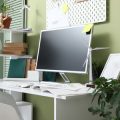1. Understanding Feng Shui Principles for the Modern Home Office
Feng Shui, an ancient Chinese practice, is all about creating harmony between people and their environments. When applied to a home office, Feng Shui helps you design a workspace that encourages productivity, creativity, and well-being. In today’s fast-paced American lifestyle, where many of us work remotely or bring work home, understanding these principles can make a big difference in how comfortable and successful we feel in our workspaces.
Core Concepts of Feng Shui
At its heart, Feng Shui focuses on the flow of energy—known as “Chi”—and how it moves through your space. The goal is to arrange your environment so that Chi flows smoothly and positively, avoiding blockages or areas where energy might stagnate. Here are some fundamental concepts:
| Feng Shui Principle | What It Means for Your Home Office |
|---|---|
| Chi (Energy Flow) | Arrange furniture to allow easy movement and avoid cramped corners. |
| Yin & Yang (Balance) | Create balance with lighting, colors, and materials—mixing soft and hard surfaces. |
| The Five Elements | Incorporate wood, fire, earth, metal, and water elements for a harmonious feel. |
| The Command Position | Sit facing the entrance of the room but not directly in line with the door for optimal focus and safety. |
Why Feng Shui Matters in American Homes Today
American homes are often designed with open spaces and multi-purpose rooms. With more people working from home than ever before, the need for a dedicated, energizing workspace has become essential. Integrating Feng Shui into your home office design can help reduce stress, improve concentration, and make work more enjoyable—no matter if you’re in a high-rise apartment in New York or a suburban house in California.
How Feng Shui Relates to Workspace Design
Your workspace should support your goals while reflecting your personal style. By applying Feng Shui principles, you can enhance both the look and function of your office. Think about how you use your space: Where do you sit? What do you see when you look up from your desk? Is there enough light? These questions are all connected to Feng Shui’s emphasis on positioning and energy flow.
Everyday Benefits You Can Experience
- Less Clutter: A tidy office supports clear thinking.
- Improved Mood: Natural light and plants bring positivity.
- Enhanced Focus: Thoughtful arrangement reduces distractions.
By understanding these basic ideas, you’re ready to start designing a home office that not only looks good but feels great to work in every day.
2. Selecting the Ideal Room for Your Home Office
When it comes to designing a home office with Feng Shui in mind, choosing the right room is your first big step. In American homes, there are often several options: a spare bedroom, basement, attic, or even part of the living area. Picking the best spot sets the tone for your productivity and well-being.
Natural Light: Boosting Energy and Focus
Natural light isn’t just good for your mood—it’s a key element in Feng Shui. Look for a room with windows that let in plenty of daylight. If you have a choice, south-facing windows are great for steady light throughout the day. Avoid dark corners or spaces that feel closed-in, like windowless basements, if possible.
Privacy Matters: Minimizing Distractions
Your home office should be a place where you can focus. Choose a room that’s away from high-traffic areas like kitchens or family rooms. If you live in a busy household, a space with a door you can close helps create boundaries between work and home life.
Energy Flow: The Heart of Feng Shui
Feng Shui emphasizes smooth energy flow, known as “chi.” Avoid setting up your office where doors open directly behind your desk or where you face a blank wall all day—this can block creativity and motivation. Instead, try to position yourself so you have a clear view of the door but aren’t directly in line with it.
Quick Guide: Choosing Your Home Office Space
| Room Option | Natural Light | Privacy | Energy Flow Potential |
|---|---|---|---|
| Spare Bedroom | Good (usually has windows) | High (door can close) | Excellent (flexible layout) |
| Living Room Corner | Very Good (open space, large windows) | Low (high traffic) | Moderate (may need screens/plants) |
| Basement | Poor (often limited light) | High (separated from main areas) | Challenging (may need extra lighting & décor) |
| Attic/Loft | Varies (depends on windows/skylights) | Medium (can be isolated, but sometimes noisy) | Good if uncluttered and well-lit |
Selecting your home office location is about balancing these factors to find what works best for your lifestyle. Remember, it’s not just about looks—the right room can boost your focus and support positive energy every workday!

3. Strategic Office Layout for Productivity and Balance
Creating a home office that supports both productivity and well-being is key to successful remote work. Using Feng Shui principles, you can arrange your workspace to encourage a healthy flow of energy (or “chi”), reduce distractions, and foster a sense of balance. Here’s how to strategically lay out your office for maximum effect.
Desk Placement: The Command Position
The most important piece of furniture in any office is the desk. In Feng Shui, placing your desk in the “command position” means you have a clear view of the door without being directly in line with it. Ideally, your back should be to a solid wall, which symbolizes support. This setup lets you see who’s coming into your space and helps you feel secure and focused.
| Desk Placement | Why It Works | Tips |
|---|---|---|
| Face the door (but not directly in front) | Keeps you aware and in control | Avoid having your back to the entrance |
| Back to a solid wall | Provides psychological support and stability | If not possible, use a tall plant or bookshelf behind you |
| Avoid facing a window directly | Minimizes distractions and glare | Use window treatments if needed |
Seating: Comfort and Support Matter
Your chair is where you’ll spend most of your time, so comfort is crucial. Choose an ergonomic chair with good lumbar support. In Feng Shui, avoid sitting with your back to a window, as this can make you feel unsupported. If that’s unavoidable, add curtains or plants for extra protection.
Tips for Choosing Your Chair:
- Select an adjustable chair to fit your body type
- Add cushions for extra comfort and grounding energy
- Avoid chairs with sharp edges or uncomfortable angles
Optimal Use of Space: Organization Equals Flow
An uncluttered workspace allows energy to move freely, supporting both creativity and efficiency. Keep only what you need on your desk—store paperwork, supplies, and equipment neatly away when not in use. Use shelves, cabinets, or organizers to keep things tidy.
| Area | Feng Shui Advice | Practical Example (U.S. Home Office) |
|---|---|---|
| Main Desk Surface | Clear clutter; keep essentials within reach | Laptop, notepad, favorite mug only on top |
| Shelves/Storage | Store books/files vertically; avoid overloading shelves above head level | Floating shelves with labeled bins for easy access |
| Corners & Walls | Add plants or soft lighting to energize dead zones (“poison arrows”) | Pothos plant or LED lamp in empty corner space |
Equipment Placement: Tech With Intention
Your computer, printer, and other devices should be positioned so cords are managed safely and don’t create trip hazards or visual clutter. Place electronic equipment slightly to one side rather than directly in front of you to avoid blocking the flow of energy.
Quick Checklist:
- Cords tucked away using cable organizers or clips
- Monitor at eye level to reduce strain on neck and shoulders
- Printer/scanner within arm’s reach but off main desk surface if possible
- Add personal touches like photos or motivational quotes for positive vibes—but don’t overdo it!
4. Enhancing Energy Flow with Decor and Colors
Decor and colors play a big part in creating the right energy for your home office. In Feng Shui, the items you choose and where you place them can influence your focus, creativity, and overall mood. The good news is that you can blend traditional Feng Shui ideas with modern American styles for a space that feels both inviting and productive.
Choosing Colors that Support Productivity
Colors have different meanings in Feng Shui and can affect how you feel in your workspace. Here’s a simple guide to help you pick colors that align with both Feng Shui principles and popular American decor trends:
| Feng Shui Element | Recommended Color | Effect on Work | Modern American Style Tip |
|---|---|---|---|
| Wood | Green, Blue | Encourages growth and creativity | Try sage green or navy blue accent walls or decor pieces |
| Fire | Red, Orange, Purple | Boosts energy and passion | Add pops of burnt orange or deep red through artwork or pillows |
| Earth | Yellow, Beige, Light Brown | Brings stability and support | Use warm tan or soft gold for rugs or wall art |
| Metal | White, Gray, Metallics | Aids clarity and focus | Select modern metallic accessories or sleek gray furniture |
| Water | Black, Deep Blue | Sparks inspiration and flow | Add dark blue vases or black-framed photos for contrast |
Selecting Artwork for Positive Vibes
The art you display in your home office should inspire you. In Feng Shui, images of nature, mountains, flowing water, or uplifting quotes are great choices. Look for pieces that motivate you without feeling overwhelming.
- Nature themes: Forest landscapes or ocean scenes bring calming vibes.
- Avoid chaos: Skip artwork with aggressive or chaotic imagery as it may disrupt your focus.
- Personal connection: Display photos or prints that remind you of your goals and achievements.
- Cultural blend: Mix in American favorites like city skylines or abstract art if they make you feel motivated.
Accessorizing with Intention
The right accessories not only look good but also help balance energy in the room. Here are some practical tips:
- Add plants: Green plants like snake plants or peace lilies clean the air and bring wood element energy. They fit well in most American homes.
- Use mirrors wisely: Mirrors can double the positive energy but avoid placing them where they reflect clutter.
- Candles and lamps: Soft lighting creates warmth (fire element) without being harsh. Choose stylish lamps that match your decor.
- Tidy up: Clutter blocks energy flow. Use baskets, shelves, or organizers to keep things neat while adding character to your office.
- Aromatherapy: A subtle essential oil diffuser can boost concentration and add a welcoming scent.
Your Home Office Decor Checklist
- Select 1-2 main Feng Shui colors that suit your taste and work needs.
- Add inspiring artwork with positive messages or calming scenes.
- Bring in live plants for fresh energy.
- Pile on cozy textures with throws or cushions in natural fabrics.
- Keep surfaces clear for smooth energy flow.
- Add personal touches—photos, souvenirs, or awards—to make the space yours.
This approach will help you create a home office where positive energy flows freely, blending Feng Shui wisdom with a style that feels right at home in any American setting.
5. Integrating Feng Shui with American Work Culture
Blending Tradition and Modern Work Habits
Creating a home office that supports both Feng Shui principles and American work culture can help you achieve a space that feels comfortable, productive, and inspiring. Here are practical suggestions for merging these two approaches:
Choosing the Right Desk Position
| Feng Shui Principle | American Work Habit | How to Blend |
|---|---|---|
| Command Position: Place your desk facing the door but not in line with it. | Emphasis on video calls and digital meetings. | Set up your desk to face the door for positive energy, and position your camera so you have a tidy, non-distracting background for virtual meetings. |
| Avoid clutter; keep workspace organized. | Multitasking with paperwork, tech devices, and snacks. | Use organizers and cable management tools to maintain order while still having essentials within reach. |
Balancing Comfort and Energy Flow
Americans value ergonomic furniture for long work hours. Choose chairs and desks that are both comfortable and made of natural materials like wood or bamboo to enhance good chi. Avoid sharp edges by selecting rounded furniture when possible.
Personalization with Purpose
Add personal touches such as family photos or inspirational quotes, which are popular in American offices. In Feng Shui, these should be placed in the south area of your office to encourage recognition and success. Include a small healthy plant—like a pothos or snake plant—to boost air quality and positive energy.
Work-Life Balance Zones
The American lifestyle often blends work and relaxation at home. Use rugs, screens, or shelving units to visually separate your office from living spaces, helping you mentally switch between work mode and home life. According to Feng Shui, this separation also prevents work stress from spilling into your personal environment.
Quick Tips Table: Integrating Feng Shui & American Work Style
| Tip | Benefit |
|---|---|
| Add natural light or soft lighting fixtures | Keeps energy fresh, reduces eye strain during long hours |
| Keep cords and cables hidden or organized | Minimizes visual clutter, supports focus and efficiency |
| Hang art or diplomas on the north wall | Aligns with career success in Feng Shui; shows achievements in American culture |
| Create a dedicated inbox area for incoming tasks | Merges American productivity habits with Feng Shuis need for orderliness |
| Take short standing breaks every hour near a window or plant | Boosts circulation (good chi) and matches American advice for regular movement at work |
By thoughtfully blending Feng Shui concepts with familiar elements of American work life, you can design a home office that not only looks great but also supports your well-being, motivation, and daily productivity.


